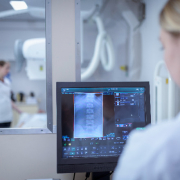Scoliosis X-rays: Why We No Longer Use Old Protections
The use of protective devices intended to shield the foetus and gonads of the patient during X-ray imaging should be discontinued as a routine practice since it can compromise its benefits. This recommendation, published in April 2019 by the American Association of Physicists in Medicine AAPM represents a historic change.
Why, after more than 70 years of gonadal protection, have we reached this conclusion?
Let’s take a closer look. At ISICO, this topic is particularly important to us because we need to visualise the spine to offer the best therapies for scoliosis and assess its progress properly. Thus, while we reduce requests as much as possible, it’s almost always necessary to prescribe complete spine X-rays in one projection (either frontal or lateral) at least once a year.
Why This Change? There Are Two Reasons:
- Minimal or No Benefits from Protections
Current scientific evidence shows that these protections provide minimal or no health benefits to patients. In the past, it was believed that radiation could damage reproductive cells, potentially harming future offspring. However, it has been discovered that reproductive cells are much less sensitive to radiation than previously thought, and there is no evidence that the very low doses currently used in diagnostic imaging can harm reproductive cells or the foetus. Radiation is not harmful to the foetus, even when a radiographic exam on a pregnant patient is necessary and indispensable. - Negative Impact on Exam Effectiveness
The protective equipment can obscure anatomy or significant pathologies or produce artefacts that require repeating the exam, thereby substantially increasing the dose. Additionally, most modern X-ray equipment can automatically adjust the amount of radiation used based on the body region being examined. Lead-equivalent individual protection in the field of view could lead to a significant and unjustified increase in the patient’s dose. These technological advancements have made patient shielding a practice that introduces more risks than benefits.
In line with this evidence, at ISICO, we discourage using these protections as they could potentially be harmful.

